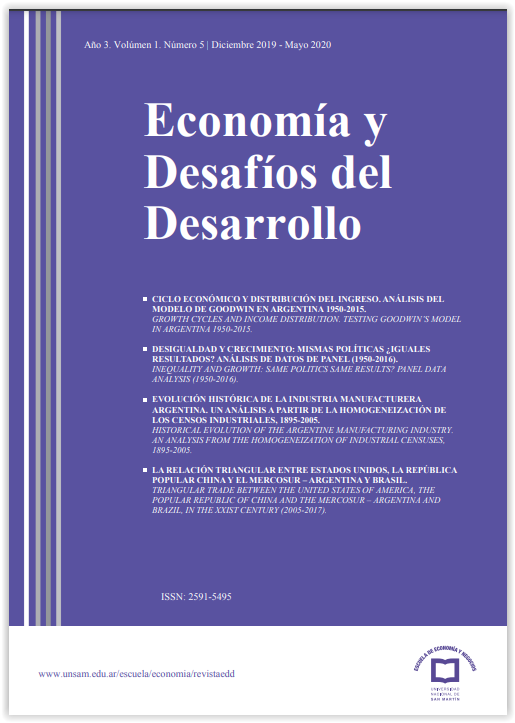Inequality and growth same politics same results?
Panel data analysis (1950-2016)
Keywords:
Inequality, Macroeconomics, Income Distribution, Economic Growth;, GINIAbstract
The impact of income distribution inequality,
measured through the GINI coefficient, on the growth of Gross Domestic Product per capita for a panel of 206 individuals (countries and dependent territories) between 1950 and 2016 is analyzed using the Generalized Method of Moments
(Arellano-Bover 1995). The results indicate that GINI is a significant variable to explain GDP growth per capita only
when observed in quadratic terms. That is, the effect is not linear but would have an inverted U shape. When presenting
this type of relationship we find an optimal GINI value, where its effect on the explained variable is maximum. This result
brings new elements to the research that helps to determine whether equality in income distribution has a direct relationship with the country’s product growth or not and in what way it does.
References
Adelman, I., y Morris, C. T. (1973). Economic growth and social equity in developing countries. Stanford University Press.
Ahluwalia, Montek S. Income distribution and development: Some stylized facts. The American Economic Review, 1976, vol. 66, no 2, p. 128-135.
Alesina, A., & Perotti, R. (1996). Income distribution, political instability, and investment. European economic review, 40(6), 1203-1228.
Barro, R. J. (2000). Inequality and Growth in a Panel of Countries. Journal of economic growth, 5(1), 5-32.
Banerjee, A. V., & Duflo, E. (2003). Inequality and growth: What can the data say?. Journal of economic growth, 8(3), 267-299.
Benhabib, J. (2003). The trade-off between inequality and growth. Annals of Economics and Finance, 4, 491-507. Traducción propia.
Birdsall, N., Pinckney, T. C., y Sabot, R. (1996). Why low inequality spurs growth: savings and investment by the Poor.
Robinson, S. (1976). A note on the U hypothesis relating income inequality and economic development. The American Economic Review, 66(3), 437-440.
Forbes, K. J. (2000). A Reassessment of the Relationship between Inequality and Growth. American economic review, 869-887.
Galor, O., y Tsiddon, D. (1997). Technological progress, mobility, and economic growth. The American Economic Review, 363-382.
Kaldor, N. (1957). A model of economic growth. The economic journal, 67(268), 591-624.
Kuznets, S. (1955). Economic growth and income inequality. The American economic review, 45(1), 1-28.
Ostry, M. J. D., Berg, M. A., y Tsangarides, M. C. G. (2014). Redistribution, inequality, and growth. International Monetary Fund.
Persson, T., & Tabellini, G. (1994). Is inequality harmful for growth?. The American economic review, 600-621.
Ram, R. (1991). Kuznets's inverted-U hypothesis: evidence from a highly developed country. Southern Economic Journal, 1112-1123.



